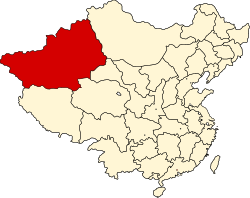Sinkiang Province, Republic of China
| Sinkiang Province 新疆省 |
|||||
|
|
|||||
|
|||||
| Sinkiang Province (red) in the Republic of China | |||||
| Capital | |||||
| Historical era | 20th Century | ||||
| • | Established | 1912 | |||
| • | Surrender to the People's Liberation Army | 13 October 1949 | |||
| • | Dissolution of the Sinkiang Provincial Government Office | 16 January 1992 | |||
| Area | |||||
| • | 1928 | 1,711,931 km2(660,980 sq mi) | |||
| Population | |||||
| • | 1928 | 2,550,000 | |||
| Density | 1.5 /km2 (3.9 /sq mi) | ||||
| Today part of | |||||
Sinkiang (Chinese: 新疆省; pinyin: Xīnjiāng shěng; or Xinjiang) refers to a former province of the Republic of China. First set up in 1884 as a province of the Qing Dynasty, it was replaced in 1955 by the Xinjiang Uyghur Autonomous Region of the People's Republic of China. The original provincial government was relocated to Taipei as the Sinkiang Provincial Government Office (新疆省政府辦事處) until its dissolution in 1992.
The province inherited the borders of the Qing Dynasty province, bordering Kansu, Tsinghai, the Mongol Area, Tibet Area, and the countries Soviet Union, Afghanistan, Pakistan, and India. The claimed boundaries of the province included all of today's Xinjiang and parts of Mongolia, Tajikistan, Afghanistan, and Pakistan. The province had an area of 1,711,931 km2.
In 1912, the Qing dynasty was replaced by the Republic of China. Yuan Dahua, the last Qing governor of Xinjiang, fled. One of his subordinates, Yang Zengxin, took control of the province and acceded in name to the Republic of China in March of the same year. Through Machiavellian politics and clever balancing of mixed ethnic constituencies, Yang maintained control over Xinjiang until his assassination in 1928 after the Northern Expedition of the Kuomintang.
...
Wikipedia

